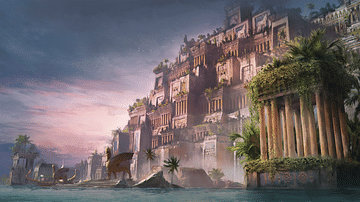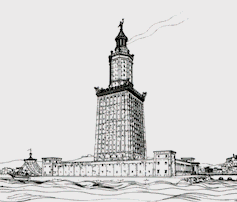Illustration
An infographic about the Seven Wonders of the Ancient World - extraordinary architectural and artistic achievements celebrated for their grandeur and innovation. The wonders included the Great Pyramid of Giza, the only surviving wonder, which served as a monumental tomb for the Egyptian Pharaoh Khufu. Although the Hanging Gardens of Babylon's actual existence and location is debated, they were described as a lush, terraced paradise built in ancient Babylon. The Statue of Zeus at Olympia was a massive gold and ivory representation of the Greek god Zeus, crafted by the sculptor Phidias. The Temple of Artemis at Ephesus was a magnificent sanctuary dedicated to the goddess Artemis, famed for its scale and intricate decoration. The Mausoleum at Halicarnassus was an elaborate tomb for Mausolus, a Persian satrap renowned for its architectural splendor and sculptural detail. The Colossus of Rhodes was a colossal bronze statue of the sun god Helios, erected to celebrate Rhodes' victory over Cyprus. Lastly, the Lighthouse of Alexandria, also known as the Pharos of Alexandria, was a towering beacon guiding sailors into the busy harbor of Alexandria.
About the Author
Cite This Work
APA Style
Netchev, S. (2024, September 13). The Seven Wonders of the Ancient World. World History Encyclopedia. Retrieved from https://www.worldhistory.org/image/19446/the-seven-wonders-of-the-ancient-world/
Chicago Style
Netchev, Simeon. "The Seven Wonders of the Ancient World." World History Encyclopedia. Last modified September 13, 2024. https://www.worldhistory.org/image/19446/the-seven-wonders-of-the-ancient-world/.
MLA Style
Netchev, Simeon. "The Seven Wonders of the Ancient World." World History Encyclopedia. World History Encyclopedia, 13 Sep 2024, https://www.worldhistory.org/image/19446/the-seven-wonders-of-the-ancient-world/. Web. 03 Jul 2025.








